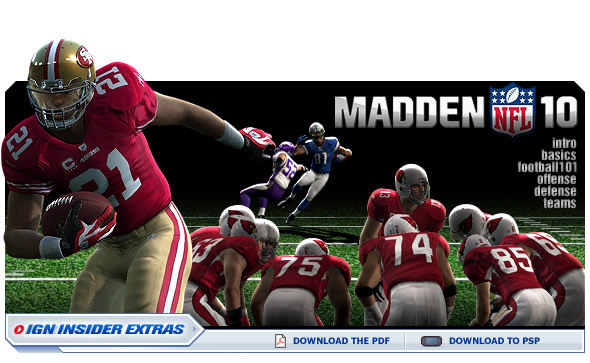
Madden NFL 10 Defense
| The defensive side of the ball is where a lot of thankless hard work comes into play. Some of the most glamourless positions in football are played on defense. This section is dedicated to the hard working defensive linemen, especially, who lack any popularly-known statistics in order to suppress the other team's offense. |
But playing defense isn't easy. There's certainly ways to cop out of it, we're not going to pretend like there's not, but understanding just what's happening on defense will make your life a lot easier when the going gets tough. Many people dread playing defense in Madden because, unlike when playing offense, few things are really explained to you. It's a more hands-off variety of the game, where all you can see in-game are your various coverage areas. Knowing your team's defensive playbook is vital, as is knowing how to counter certain plays and formations.
Don't worry--we got you covered. We're not going to suggest to you "do this for this play," because you really have to take so many things into account. For instance, there's no guarantee that a team on 3rd and 20 will throw the ball. It depends on so many factors. But we will show you to follow some trends, and do certain things that will likely make your defense more successful. Other than that, playing defense is largely a by-feel endeavor. The more you play defense and become comfortable with your team's playbook, the better your defense's so-called "anti-production" will be.
|
|
|
|
Blitzing is fun and should be done often. If you're playing a skilled CPU or human opponent, blitzing doesn't make much sense on every play since they can adjust accordingly. But if you're an average Madden player playing through a franchise or against a friend, throwing a blitz on every play doesn't hurt, as long as you have the pass and other run options properly covered to the best of your ability as well. Remember, it's better to be safe than sorry in football. Blitzing is a risk, so make sure it's a calculated risk. Don't call a 4-3 blitz on your own five yard line when the other team can run the rock right up the middle into the end zone. Call them to ensure that they don't get to that point to begin with. Putting the other team in constant pressure situations will only make your life that much easier.
| Inherent In-Game Variables |
| No matter how hard a developer tries, football games won't play exactly like their real life counterparts. This is actually a positive thing since, in regular modes of gameplay, you can literally switch between any player on the defensive side of the ball. This is Madden's inherent in-game variable, because it allows you to get firsthand, controlled coverage of literally anyone on the field. You can throw a tackle with a defensive linemen or prevent a wide receiver from making a reception with your cornerback... and you can do that on the same play. Make sure to toggle between your players and get the most out of your defense - otherwise, the defense can be highly computer-controlled... and wouldn't you rather praise your successes and blame your failures on yourself than the CPU? |
| Interceptions and Fumbles |
| The fun part of playing defense is completely flipping the script on your opponent with game-breaking defensive plays that will put your team back on the offensive side of the ball. Remember that you have full control over stripping balls from your opponent's clutches, or scooping a ball from midair right before it strikes the receivers hands. While these things happen randomly and automatically at times, by controlling these players in said situations, you can catalyze events that would make them happen more often. And naturally, that benefits you and your team. Interceptions are more straight-forward in that once you intercept a ball, you simply want to run towards the other endzone, hopefully scoring, but at least getting some positive yardage for your offense to work with. Controlling a fumbled ball is a horse of a different color, since you must first gain control of the ball before you can do anything with it. In most cases, it's more conducive to your cause to simply jump on the ball, downing it and securing possession for your team, rather than trying to pick up the oddly-shaped ball, gaining possession, and going some extra yards. Of course, the situations will differ as they come at you, but this is a general rule. Interceptions will almost always net you some positive yards. Fumbles will simply give you possession. Don't push it! |
| Give us feedback! | On to Teams... |
Grand Theft Auto: Chinatown Wars Cheats
LEGO The Lord of the Rings Cheats
Naruto Shippuden: Ultimate Ninja Heroes 3 Cheats
Persona 4 Golden Cheats
The 3rd Birthday Cheats
Final Fantasy VII Cheats
WWE SmackDown vs. Raw 2010 Cheats
Resistance: Retribution Cheats
Naruto Shippuden: Legends: Akatsuki Rising Cheats
LEGO Batman 2: DC Super Heroes Cheats
NDS
Professor Layton and the Last Specter
X360
Forza Motorsport 4
Wii
Rune Factory: Tides of Destiny
NDS
Harvest Moon: The Tale of Two Towns
PS3
Dark Souls
PC
Dark Souls (Prepare to Die Edition)
X360
Warhammer 40,000: Space Marine
Web
War Commander
PS3
Ultimate Marvel Vs. Capcom 3
X360
Trials Evolution
|
Madden NFL 10 at IGN
Madden NFL 10 Guide at IGN
Madden NFL 10 at GameSpy
Madden NFL 10 at GameStats
|